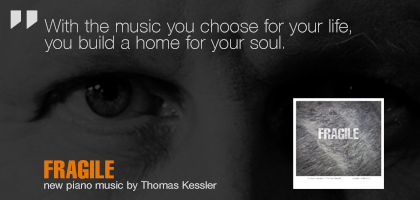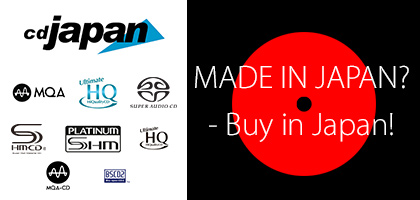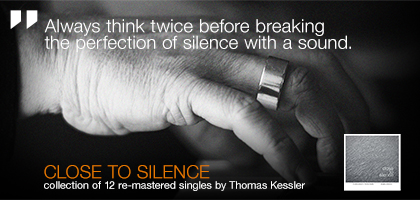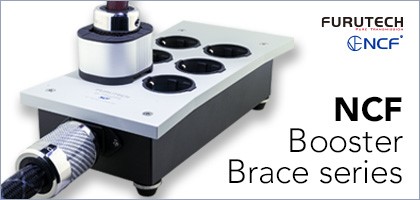No. 258 November 2025
- COVER REVIEW: BLADELIUS Oden II Class-A ⸜ integrated amplifier » SWEDEN
- INTERVIEW: "The Editors" series № 37: ANDREW SIMPSONS • Audiograde ⸜ editor-in-chief » UNITED KINGDOM
- TECHNIQUE: digital recorders: DENON PCM part 2 - DN-23R tape recorder || 1972-1974 » JAPAN
- REVIEW: ACOUSTIC REVIVE RTP-4EU Final ⸜ AC power strip » JAPAN
- REVIEW: AUDIO REVEAL Classic ⸜ integrated amplifier » POLAND
- REVIEW: FOUND SOUND DAVIO Davio Azure ⸜ digital-to-analogue converter » POLAND
- REVIEW: LAIV Harmony GaNM ⸜ power amplifier • monoblocks » SINGAPORE
- MUSIC ⸜ Our albums series: ASTOR PIAZZOLA AND HIS TANGO QUINTET, Live in Lugano 1983, Ermitage/AudioNautes Recordings, Ultimate HiQualityCD


|

|
|
PLANETA JARRE 
photo Sony Music On September 14 current year, Sony Music Entertainment Germany released the album Planet Jarre (50 Years Of Music) with the biggest hits of the Father of Electronic Music, as he is called in the publisher's materials; the album was released with the Columbia Records logo. There are 41 tracks on two discs (CD version), including four previously unreleased: two completely new ones - Coachella Opening and Herbalizer and two from the artist's archive - Music for Supermarkets (Demo Excerpt) and AOR BLEU. Jarre described it this way: While working on this project I realized that I have four completely different composition styles. There is a common view that people focus on short moments of music through continuous shuffling. This is not necessarily true. In our everyday life, we spend more and more time listening to playlists. Wherever we are and whatever we do. For this reason, I decided to divide this project into four different parts, four different worlds that create my own world ... my own planet. And I hope that you will like this trip.
Four parts of the album are: Soundscapes, Themes, Sequences, Explorations & Early Works. Soundsapes are "sound landscapes" such as Oxygene 1, Equinoxe 2 and Chronology 1. Themes includes tracks with song-like structures such as: Oxygene 2, Oxygene 4, Zoolookologie and Industrial Revolution Part 2. Nine tracks in the section titled Sequences are based on repetitive and hypnotic sequences, such as Arpeggiator and Revolutions. There is also a newer track Stardust, recorded together with the club music star Armin van Buuren. And finally the part entitled Explorations & Early Works, where we will find an unreleased demo recording from the mythical album Music For Supermarkets, which remained from the album destroyed by the artist after the radio broadcast. 
Photo Sony Music The Planet Jarre is to be a kind of summary of the 50-year presence on stage of this French musician, who is largely responsible for the contemporary perception of electronic music by so-called "ordinary" people. And his power of influence is huge because he sold over 80 million records! The album was released without any major announcements, just like the previous selection published in 2015, the Essential Recollection. Much more time has been devoted to Jarre's other release entitled Equinox Infinity, which will be available from November 16th. This is to be the continuation of his previous album Equinox from 1978. So it would be the second album "further developed" by Jarre, after Oxygene II and Oxygene III. | THE RELEASE Equinox Infinity and Planet Jarre similarities don't stop with the name of the musician and of the record label - both releases are available not only on "regular" CDs, but also in the form of boxes. For the first time, Jarre joined the trend, which can be called the "Super Deluxe Box Edition", with his two-part album Electronica Project, which could also be purchased in the form of a large box in 2015 and 2016 (it included following parts: Electronica 1: The Time Machine, Electronica 2: The Heart of Noise; more HERE). A similar form was given to the box called Planet Jarre. Although there are two CD versions - a double digipak album with a booklet ("Deluxe Edition") and a double album in a jewelbox ("Anniversary Edition"), as well as a vinyl version – with four records, the Deluxe Fan Box is obviously the most interesting one. It includes the CD version of the album, exactly the same as the basic digipak, plus two cassette tapes and a badge with the code authorizing owner to download the album in WAV 24 bit / 48 kHz files; in addition to the tracks from the album, one also receives 12 tracks mixed in 5.1 surround sound. 
To be honest, for a special anniversary box it is definitely not enough. I think that boxes should be signed by the artist, there should be a booklet with a long essay, album covers and bibliography, with previously unreleased photos, also from the recording studio. CDs that can be purchased much cheaper without a box, and two cassettes are simply not enough to call this release a luxury product. And the code allowing user to download files one gets also with the vinyl version. In a word – it offers me no emotion. | FOUR REMASTERED SIDES Jarre already had a few The best of… albums such as: The Essential Jean-Michel Jarre (1983), Images - The Best of Jean Michel Jarre (1991), Essentials & Rarities (2011 ), Aero (2014) and Essential Recollection (2015). The Planet Jarre is now the sixth or seventh compilation CD with original tracks by this artist. It is worth noting, however, that the artist had some idea for each of these albums that they were not simple compilations, one can find hundreds of on the market. What is worth the interest this time is the sound. As we read in promotional materials, all tracks have been chosen by Jarre, but someone else is responsible for the re-mastering – Mr. David Perreau from Yakuda Mastering. In the booklet there is also information that when working on these materials, a "new FiDef algorithm" was used. Unfortunately, I haven't found any information whether the recordings were remastered from original analog and digital tapes or from already existing re-masters David Perreau | David Perreau is a French sound engineer, mastering engineer. Born in 1968, he studied physics at Grandmont Tours and began his career in 1989 at Radio France. Five years later he joined the multimedia NRJ Group, where he stayed for the next thirteen years. He was responsible for supervising sound processing in all radio stations of this group in France and abroad. He then took over the technical management of the audio service in 1998 and pursued numerous technical projects like digitizing the group's studios. In 2002 he decided to start his own company - he founded the DPMS Mastering Sound Design in Paris. It was thanks to his clients that he met with Jarre for the first time, when the latter, dissatisfied with the mastering work done on his album Geometry of love, was looking for someone who would improve it (2003). In this way, their long-term cooperation began, which continues to this day. Another project was the album Aero (2004), and in particular its multi-channel version released on a DVD. His greatest achievement in this field is the 5.1 soundtrack for the Jarre in China concert, which received the official THX Ultra 2 certificate (2004). 
Photo Sony Music From 2007, he started to use the pseudonym Dave Dadwater (father + water). In 2010, he founded another studio, Yakuda Audio, specializing in sound processing for radio and television broadcasting. Soon after, Perreau was hired by Jarre to remastered the entire artist's catalog. The first album that was prepared by him was the Rarities (2011). Work on subsequent titles lasted from 2011 to 2015. David Perreau's re-masters received mixed assessments. Just read the entries on Steve Hoffman's forum to see why (more HERE, accessed 22/10/2018). The most common objection is the strong compression that he uses, as well as pushing everything up to the maximum level. This results in trimming of dynamics. In addition, his recordings have quite strongly underlined leading edge and sound quite bright. |
FiDef | Man is one thing and technique is another. We don't known whether the material for this compilation was remastered from master tapes or not – my guess – it wasn't. But to add something to the existing version, the FiDef solution offered by the company with the same name was used. It's an algorithm for sound processing. Its authors are Messrs. Jayson Tomlin and Jeff Wilson, also Gary Kranz works with them responsible for, for example, the eight first albums of Steely Dan, albums by Prince, Dire Straits, Chaka Khan. Among the studio's clients, there are, among others: Jeff Greenberg – the head of The Village Studios, Al Schmitt - holder of 22 Grammy Awards and 160 Platinum and Gold Discs, as well as Elliot Scheiner - sound engineer and producer at the A & R Studios, responsible for the albums of such artists as: Foo Fighters, Beck, Nine Inch Nails, Faith Hill, Steely Dan, Van Morrison, Queen, Fleetwood Mac, Sting, The Eagles, Eric Clapton, Aerosmith. 
photo Sony Music What does FiDef do? As it reads on the company's website "by replacing essential audio cues not captured by microphones, FiDef activates the full potential of our auditory systems, resulting in a more engaging, emotional, and accurate listening experience." (more HERE). So it's a psychoacoustics-based processing. How exactly the algorithm works – we don't know. It is not available as a software plug-in or as an external device. One sends music files to the studio, pays the bill, and in a few days receives properly coded files back. Some say it's sort of a dynamic equalization, but it's just a speculation. | SOUND Składanki | Planet Jarre represents a significantly different approach to musical matter than the two previous compilations, both in terms of artistic and technical aspects. Correction of the artistic side is manifested by slightly modified versions of parts of the tracks, as if they were newly remixed. In general, they are close to the originals, but they differ in details. For example - in the Last Randes-Vous, the saxophone in the 50th anniversary version moves between the channels, and the introduction to the tracks has been enriched with new sounds. In turn, in the Revolution, the whole, atmospheric introduction was edited (cut out). But the sound is equally different. Planet Jarre sounds much deeper and brighter, as if they were trying to "improve" the original analog sound of most discs. Sometimes, as in the above-mentioned Last Randes-Vous, it brings interesting effects, because it gives the track a great pulse that wasn't there in the previous remaster. Space was treated completely different than in the Essential Recollection. Essential ... is full of sound effects, sounds surround listener almost all the time. On Planet ... they are quite static, placed in front of us. But the problem is something else - by emphasizing the edges of the band the midrange becomes less important. This part of the range is poorer internally, more boring. Where does it come from? I think that from the lower resolution of the new re-mastering Such sound should work great in the car, at work - wherever there is a fairly high level of background noise. The new version will be able to better get through it, the more so, it is louder than previous compilations by some 2-3 dB. Albums – re-masters | Oxygene 1 in the Mobile Fidelity Sound Lab version clearly shows what has changed in the approach to Jarre's sound. The MFSL disc is much darker. It's deeper. It is smoother and more velvety. The new version emphasizes attack, details, while withdrawing textures, which is what the whole album is based on. The advantage of the version from Planet Jarre is better depth of the stage. The width of the American version is insanely good in its focus and saturation. 
Differences between tracks released on the new compilation and Scott Hull's remaster from 1997 are even more surprising. The latest versions of the tracks are much louder, which suggests the use of stronger compression. But they are also pushed to the limits and with distinct contours, which in turn suggests cutting part of the dynamics at the 0 dB level in the limiter. In other words: "Loudness War" at its best. The difference between PJ and Magnetic Fields was unbelievable. The album sounded dark, warm, it was closed on top, while PF sounded open. But it was brightness, not information. And there is also the bass – on PF powerful, low but also sluggish, without proper control. Although the Scot Hull's version is not perfect, it moves away from the analog original in the direction of fine-tuning the lower midrange and withdrawing the top, it is much more interesting than the version released on PF. Differences of a similar scale could also be heard comparing PF and the Japanese version of the concert album The Concerts in China, also remastered by Scott Hull. The album sounds richer and denser. At first glance, it's less involving, maybe even boring, but it's a sham. In fact, this is the right version, that's how the tracks develop. On PF everything is rushes forward, it is "here and now" in every second. When you can hear snappers in the Souvenir of China, they are extremely dominant. In the Scot Hull version, they are embedded in the background, and the panorama is located further away from us. 
Albums – originals (digital) | All the above remarks can also be applied to the differences between the first digital editions and the Planet Jarre version. The former ones are darker, richer, have more layers. PJ is brighter, more "forward-sounding", has a boosted bass and a strong top, and above all it is much louder. Originals seem to be boring because of this - a comparison of this type always at first promotes something louder and more "gimmicky." But give it time, listen to the longer passages, and it will turn out that the Planet Jarre is simply tiring. | What's next? To me the direction chosen by Jean-Michel Jarre and David Perreau seems wrong. Although the desire to emphasize details, to give the music more kick could already be heard on the Oxygene 7-13 (1997), culminating in the Téo & Téa (2007), which made it unlistenable despite the fact that it has interesting musical fragments. It's the same story with Jarre's new re-masters, including the new compilation. It is incomprehensible for me why the Essential Recollection sounds so good, so engaging, since it was prepared by the same people. But this has cleared the situation and it is easier to recommend specific releases to music fans who want to have the best digital version. The first two albums, that is: Oxygene and Equinoxe were remastered in 1994 and 1995 by Mobile Fidelity Sound Labs. They were released on 180-gram LPs and gold CD discs. These are the most perfect versions of these recordings, even better than the French originals. They are, unfortunately, very expensive. CDs cost from 150 to 250 dollars, and LP even up to 500 dollars. 
The second choice should be the original French editions (Dreyfuss), and then the British ones (Polydor). This goes also for CDs, but it is worth looking for the so-called "blue face" version, that is, with blue discs, or the two first editions from the mid-1980s, with a red print, the so-called "Red face" ones. And finally, there is the 1997 remaster of the entire catalog prepared by the Sterling Studio by Scot Hull (24/96). It's really a good remaster, though quite dark sounding and a bit more compressed. The new re-masters are highly compressed and I would rather avoid them. And if you're looking for a compilation you should choose the one that has already been mentioned several times, the Essential Recollection in the Blu-spec CD2 version. ■ |
About Us |
We cooperate |
Patrons |
|
Our reviewers regularly contribute to “Enjoy the Music.com”, “Positive-Feedback.com”, “HiFiStatement.net” and “Hi-Fi Choice & Home Cinema. Edycja Polska” . "High Fidelity" is a monthly magazine dedicated to high quality sound. It has been published since May 1st, 2004. Up until October 2008, the magazine was called "High Fidelity OnLine", but since November 2008 it has been registered under the new title. "High Fidelity" is an online magazine, i.e. it is only published on the web. For the last few years it has been published both in Polish and in English. Thanks to our English section, the magazine has now a worldwide reach - statistics show that we have readers from almost every country in the world. Once a year, we prepare a printed edition of one of reviews published online. This unique, limited collector's edition is given to the visitors of the Audio Show in Warsaw, Poland, held in November of each year. For years, "High Fidelity" has been cooperating with other audio magazines, including “Enjoy the Music.com” and “Positive-Feedback.com” in the U.S. and “HiFiStatement.net” in Germany. Our reviews have also been published by “6moons.com”. You can contact any of our contributors by clicking his email address on our CONTACT page. |
 



|
   |
main page | archive | contact | kts
© 2009 HighFidelity, design by PikselStudio,
projektowanie stron www: Indecity










